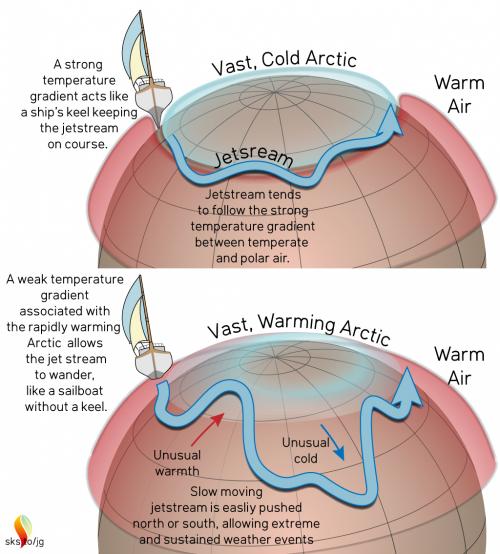
Slowly pull up the keel of a sailboat as it’s racing straight across a large lake, and soon it will begin to wallow around at the mercy of the wind.
In the physical world large differences cause the motion of things:
The temperature difference between the warm Equator and the cold Arctic causes large-scale air motion to the Arctic. Like a river raging straight down a steep mountain, a large temperature difference causes air to move northward from the Equator fast and straight, bending with the rotation of the Earth to create a well-behaved jet stream that moves from West to East. The motion is reminiscent of a well-trimmed sailboat challenging the wind as it races straight and true across a large body of water.
It is well documented that the Arctic is warming at 2 to 4 times the global average rate (read here and here). This decreases the temperature difference between the Equator and the Arctic, which decreases the driving force for the Jet Stream winds. The weakened driving force allows the jet stream to wallow around, just like a river that slowly meanders back and forth when it hits an area with only a slight elevation change (think flat). The image is similar to how a sailboat flounders about when the keel is pulled up: moving at the mercy of the wind instead of challenging it. In the same way that healthy arctic ice is linked with a strong, healthy jet stream that tracks relatively straight and true around the earth, so too a strong, deep keel is linked to a sailboat that tracks straight and true.

It is the melting Arctic ice that is causing the jet stream to lose its “keel” and change from tracking straight around the globe from West to East, and instead meander aimlessly. Remembering that the temperature of ice is 0°C or colder, as long as there is ice there are stable, constant, cold temperatures in the Arctic. Once the ice is gone, the water is free to warm up to any temperature above 0°C. The fundamental cause of the decreasing temperature difference between the Equator and the Arctic is melting Arctic ice, but the reason for the rapid warming is the changing albedo from reflective ice to absorbing ocean water.
The relationship between the temperature difference of the Equator and the Arctic and weather patterns is complex, and is a topic of active, ongoing research. Although the link between the rapidly warming arctic and the disrupted jet stream is solid, and although the link between the wavy jet stream and extreme weather is solid, the details of how the wavy jet stream is affecting weather is an active area of research. For those interested, researchers like Michel Mann, Stephen Rahmstorf, Jennifer Francis, Kerry Emanuel, Tom Knutson, Kevin Trenberth, and many others are actively researching the link between global warming and storms, and readers are encouraged to follow the work of these researchers. But here is a short summary of some of what is believed to be possible links between global warming and changing weather patterns.
We now have a sailboat circumnavigating the Earth with a broken keel, wallowing about. It is not clear what if anything we can do about this. Even if we are wildly successful at controlling GHG emissions and are able to limit total warming to 2°C, the wild weather we’ve been increasingly experiencing will likely be with us for a very long time.
Posted by Evan on Monday, 3 December, 2018
 |
The Skeptical Science website by Skeptical Science is licensed under a Creative Commons Attribution 3.0 Unported License. |